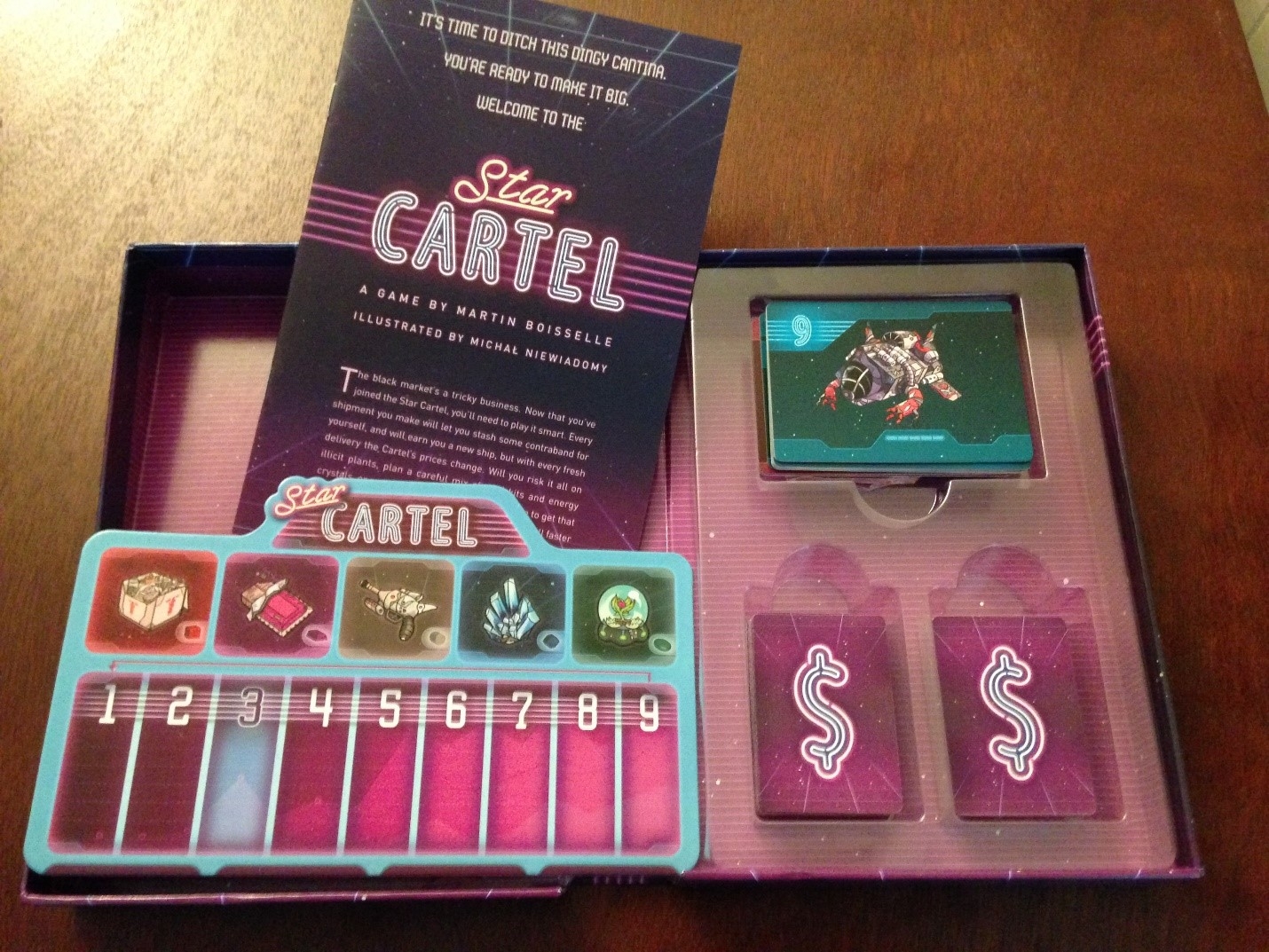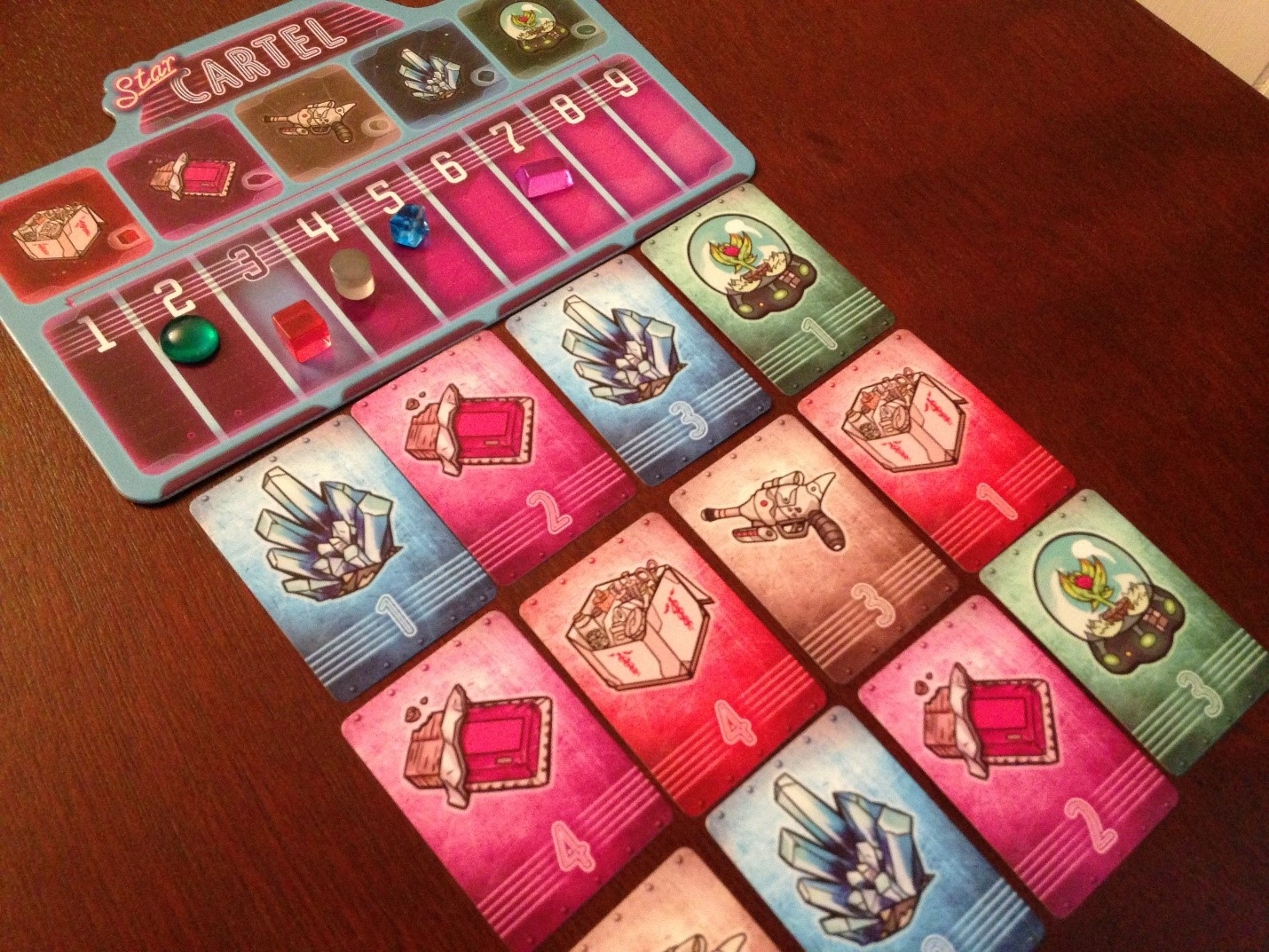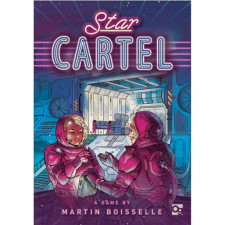Star Cartel Review
on Nov 6, 2017
Critical Hits: Deep and fast, engaging market system
Critical Misses: Volatile; hard to plan ahead, setting is thin
If there's one thing I enjoy in life it's working for the cartel. The hum-drum nature of the day-to-day accounting is offset by ordering hits alongside delicious plates of caviar. You'd never guess this by looking at me, but I'm one badass MOFO who's seen some stuff you don't come back from.
What does this have to do with Star Cartel? Not much really. The premise of this new Osprey Games title from designer Martin Boisselle is somewhat duct-taped on. In actuality this is a small footprint economic game with some very subtle strategy points. The whole galactic cartel thing makes for some neat visuals and for some funny jokes about manipulating the price of a pink space Snickers. But you never feel as though you're really delivering elicit goods or operating on the dark edge of the space-trade sector.
Setting particularities aside, Star Cartel does capture the mental gymnastics of manipulating dynamic markets and attempting to finagle your way into economic superiority. Player decisions on what and how many to sell directly impacts the worth of goods and forms the basis of this game's most delicious mechanism.

It may be small, but it’s got the looks.
Let's take a step back and lay down the space law. In addition to the cardboard track that displays the value of the five types of goods, the center of play consists of small cards in a grid of four columns by three rows. Each turn you'll choose a card from the bottom row to load onto your ship. You may optionally choose a second product if you'd like, but you need to be rather discriminatory. As soon as you hit the capacity of your ship's hold you will deliver, which is the vehicle to banking sweet digital coin at end game.
Delivering goods to the cartel consists of discarding your lowest and highest quantity item types while keeping a single set that remains. So if you have weapon cards totaling a value of five and crystals with a total of one, both of those will get discarded and you can keep the three weird vegetable snow globes lining your smuggling compartments. If you have more than one good remaining after selling off the highs and lows, you choose which of the two to keep.
The “value†noted here is not the set price of the market, but rather the amount listed on the face of the card. These numbers vary within a type of good which proves for a more layered market with difficult decisions.

Hungry - why wait?
Those illicit items tucked away score points at the end of play based on the final market price. You no longer take into consideration the numeric printed on the card - as this is just used for loading - and instead focus on the player manipulated number on the market.
That market board is the heart of the game and wrestling with the strategic challenges surrounding it prove satisfying. The value of deliverables change based on player action; if you discard a set of cards as your lowest total good in a delivery, then the market value for that type drops by one. On the other hand, the set you discard with the highest value increases by two. The catch is that a good that pushes above a market price of nine drops back down to one – which can be downright evil.
It quickly becomes clear that what you load and how you arrange your hold to deliver is quite nuanced for a 20 minute game. You'll want to stash goods that will be worth more at the end of play while pushing the prices up and down based on what your opponent's are squirreling away. Performing these tasks while navigating available goods and managing your hold size is challenging.
A further wrinkle develops in that each time you deliver you toss out your old ship card and acquire a new one from the top of the deck. Every five minutes your little green used ship salesman pings you on the wireless and offers a wink. Who can say no to trading in a laser-scorched pinto for a sexy red ‘vette? Not this guy.
Ship hold sizes escalate as the game progresses and most vessels even possess special powers. These abilities allow you to perform tasks such as taking cards from a non-bottom row or messing with the market prices after delivery. They're interesting to varying degrees but add another tool you must master in order to crank the economic engine to its utmost potential.
Those looking for an economic filler-plus design will find a lot to love in this box. It's a streamlined affair that is easy as a space Snickers to teach but will support a multitude of plays in order to command its finer points.
The one quality which may rub some the wrong way is the “Five Tribes Factorâ€. By that, I mean that the rows of goods can be extremely volatile, particularly at higher player counts. That results in a play-state where it can prove very difficult to plan your move ahead of time. This isn’t an enormous problem as the design moves along at a thruster’s pace, but it has the potential to nag certain personalities.

We’re heading your way like dynamite. Uh, delivering the goods!
Star Cartel may lack narrative and flair, but it does sit in this comfortable sphere where it lacks any true competition from the industry. Most similarly sized releases tend to lean towards worker placement or action manipulation such as the fine Sail to India. The only games that capture an identical spirit tend to be large and verbose. Star Cartel is brief and snappy and completely at the opposite end of the spectrum.
This is a thoughtful small footprint design that can wheedle away at your brain in the off hours. Its direct personality is laid bare and it doesn't really hold anything back. If you're looking for a cognitive lark and want to rub some space bucks between your fingers, make room in your smuggler's hold for Star Cartel.

 Customer Support
Customer Support  Subscribe
Subscribe 




 Account
Account  Wishlist
Wishlist 

